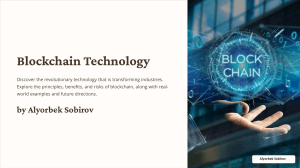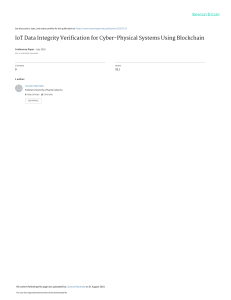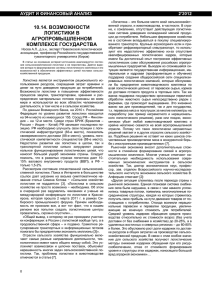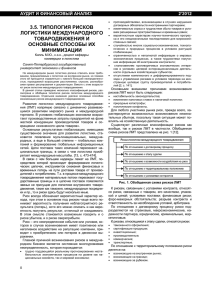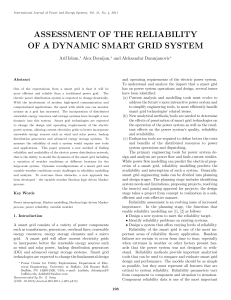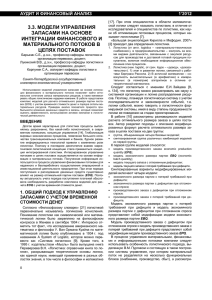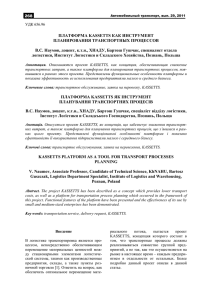ABI Research Blockchain Impacting Industrial Manufacturing 04112018
реклама
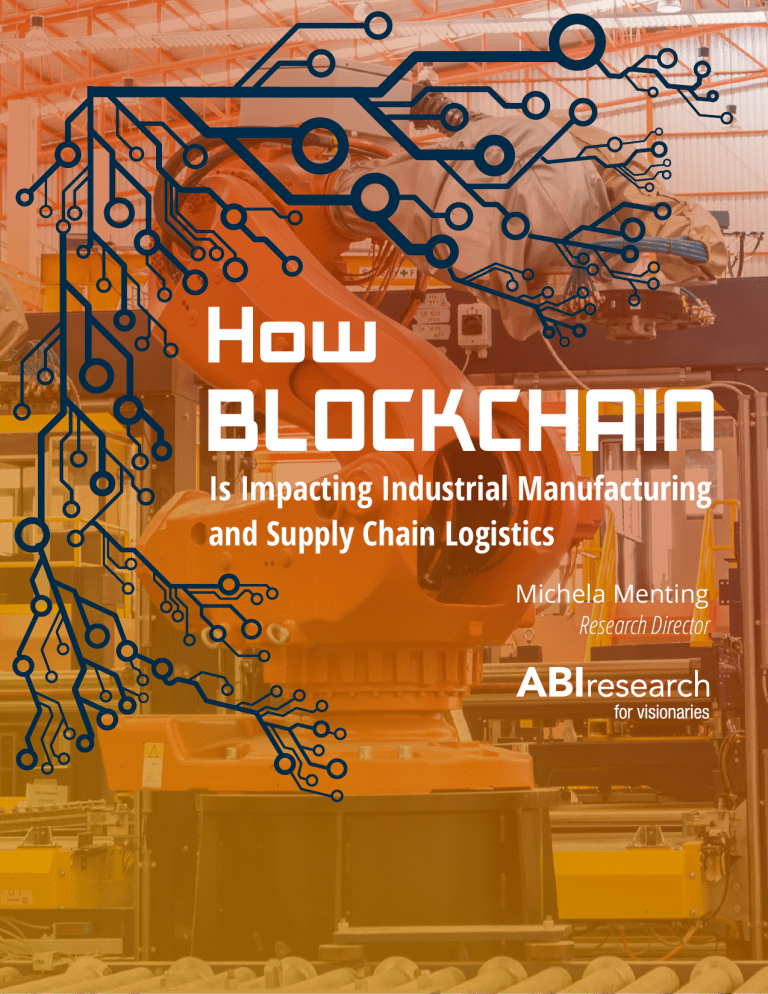
How
BLOCKCHAIN
Is Impacting Industrial Manufacturing
and Supply Chain Logistics
Michela Menting
Research Director
IS BLOCKCHAIN A VIABLE
TECHNOLOGY FOR INDUSTRY 4.0?
BACKGROUNDING INFORMATION: DEFINING BLOCKCHAIN,
SMART CONTRACTS AND DAOs
Blockchain is essentially a ledger technology that uses cryptography to provide an authoritative record of secure transactions. By
doing away with a trusted centralized middle man responsible for the ledger, blockchain allows for a “trustless trust.” The three primary
transformative features are immutability, transparency, and autonomy.
The transactions, once verified and accepted, are cemented into blocks and then appended to the chain. The synchronized replication
across all distributed nodes and the use of cryptographic hashing is what provides the transparency — the immutable record — of
transactions, with the data viewable to all the participants.
Blockchain has truly evolved from its bitcoin origin a decade ago and has moved beyond cryptocurrency just for digital payments. Now,
business logic can be programmed through smart contracts and contractual agreements that can be automatically executed between
peer-to-peer or machine to machine (M2M).
This provides a new level of autonomy. Smart contracts can be programmed to do many things: release funds, communicate
information, and record and embed data, all in a pre-programmed, self-executing, and autonomous manner. Furthermore, digital
identities can be created for physical properties and intangible assets with the ownership of those controlled through smart contracts.
BLOCK
BLOCKCHAIN
SMART CONTRACT
BLOCK # 1
NONCE
BLOCK # 2
56327
SMART CODE TO BE EXCUTED
NONCE
BLOCK # 3
98272
SMART CODE TO BE EXCUTED
if(condition #1){
if(condition #1){
//do something
}elseIf(condition #2){
//do something
}elseIf(condition #2){
//do something else if condition 2 is met
}elseIf(condition #2){
//do something else if condition 2 is met
}else{
//do something else if condition 2 is met
}else{
//do something else
}else{
//do something else
}
//do something else
}
DATA
}
DATA
Electronic medical records
19837
SMART CODE TO BE EXCUTED
if(condition #1){
//do something
NONCE
DATA
Logistics and supply chain information
Electric vehicle charging stations
HASH 56857CFC709D3996F057252C16EC4656F5292802
HASH 2D86C4246F3C0EB516628BF324D6B9A3GREWGRK
HASH FF6626C69507A6F511CC398998905670R74H2UH3
HASH OF THE PREVIOUS BLOCK 0000000000000000000000000000000000000000
HASH OF THE PREVIOUS BLOCK 56857CFC709D3996F057252C16EC4656F5292802
HASH OF THE PREVIOUS BLOCK 2D86C4246F3C0EB516628BF324D6B9A3GREWGRK
TIME STAMP
JUNE 23 2017
MINE (SIGNATURE)
TIME STAMP
JUNE 30 2017
MINE (SIGNATURE)
TIME STAMP
JULY 3 2017
MINE (SIGNATURE)
Blockchain can be utilized through smart contracts that can be programmed to execute automatically.
www.abiresearch.com
HOW BLOCKCHAIN IS IMPACTING INDUSTRIAL MANUFACTURING AND SUPPLY CHAIN LOGISTICS
2
Moving beyond smart contracts is the idea of decentralized autonomous organizations (DAOs). At the core, they are AI-based
autonomous agents. DAOs are best defined as a set of long-lasting smart contracts. They can be a party to a smart contract, but they
can also be used to implement more complex governance structures — owning, exchanging and trading resources, interacting with
other parties (human and machine), and executing pre-defined tasks.
DAOS
INDUSTRIAL DRIVERS
The key drivers for blockchain and Industry 4.0 are automation,
Decentralized Autonomous Organizations
connectivity, and digitization. Couple that with greater intelligence
through analytics and data rationalization, and the implementation of
Corporate
Governance
Smart Diagnostics &
Machine Maintenance
Smart Contracts
smarter operations can begin. Industrial IoT (Internet of Things) and
cyberphysical systems represent the most popular realization of those
key drivers. Industry 4.0 is making use of new technology developments,
e-Government and
e-Citizen Services
such as IoT and cyber systems, to improve operations and management
in industrial settings. Supporting these are global investments to expand
the implementation of technology and consortium efforts to increase
inter-operability and integration within the evolution.
Ethereum blockchain
Decentralized Autonomous Organizations can be
used to implement more complex governance
structures, such as interacting with third parties
and executing pre-defined tasks.
The transition to Industry 4.0 won’t be easy. The industrial vendor
landscape is still relatively conservative, stemming from a siloed
structure where OEMs like to keep tight control over processes. At
the same time, the plant network is rather fragmented with a mix of
propriety and open source technology. Logistically, machine lifespan
and safety can be critical issues, and any changes that will affect
those will take time. Overall, the industry in general is a bit slower to change. They need to carefully weigh the benefits of undergoing
significant structural changes. But the ecosystem is changing toward increased technology adoption.
INDUSTRY 4.0 ISSUES
Technology adoption to an Industry 4.0 context is not without a range of issues. Contract manufacturing, for example, is increasingly on
the rise, and new players from the technology sector are targeting the industry, making logistics more complex and creating a crowded
supply chain, meaning less visibility end-to-end. This can also lead to issues with accountability and auditing. Thus, participants can only
see so far either upstream or downstream. There are also the continuing issues of IP theft, counterfeiting and the cloning of products
that are increasingly common in contract manufacturing and along the supply chain. Overall, there are a lot of teething issues around
4.0 operational processes and adopting new technologies. Operators need to integrate them with existing legacy systems, which can
be a complex affair, making for uncertain uptime, slower provisioning, and trickier maintenance.
BLOCKCHAIN ENABLEMENT
Blockchain enablement is where blockchain can step in to resolve some issues — not by replacing the existing technology — but by
bridging some of those gaps and offering some solutions to these ingrained issues.
For example, public ledger can provide transparency and visibility end-to-end from the product source all the way through to final
form and delivery post-market. Smart contracts and DAOs can make deployments more autonomous and more intelligent, enabling
machines to carry out tasks faster by taking them over from the human element and essentially automating them.
Blockchain can enable OEMs and contractors to more effectively optimize and streamline processes and add new value to operations.
www.abiresearch.com
HOW BLOCKCHAIN IS IMPACTING INDUSTRIAL MANUFACTURING AND SUPPLY CHAIN LOGISTICS
3
THE BARRIERS AND CHALLENGES TO BLOCKCHAIN
Despite its potential, blockchain does face some challenges and barriers to growth. It is still a nascent
technology, despite bitcoin and cryptocurrency — which one could consider the 1.0 version — being a
decade old. The focus on blockchain now centers around how to commercialize a 2.0 version, with smart
contracts and DAOs. The key takeaway to remember is trustless trust and breaking down barriers that
have formed around centralized systems. Blockchain will not stick in areas that are controlled end-to-end
by one entity, where there is already trust in the process. Blockchain for the sake of blockchain is simply
not a good business model. For participants, of course, the big questions will be around cost: What is it
going to cost to implement and deploy? What is it going to cost to replace, especially where some costs
are already sunk for existing infrastructure? What kind of resources are needed to keep it up and running?
The point to consider about blockchain is you don’t need substantial investment or change to integrate it. It’s not about sharing
everything you have in your database or replacing them completely with blockchain. It’s about selecting what you want to share from
your own data so the blockchain can then abstract it and share on a new ledger that can then be permissioned to other participants.
Of course, there will be a need for minimal integration, but it’s about leveraging the tools already in place. RFID (radio frequency
identification) is a prime example of how to incorporate blockchain into a tool that already exists and make better use of it — which
potentially becomes more about plug-ins and APIs than replacing a whole infrastructure.
Another concern will be around scale: How quickly and cost-effectively can the solution scale? When you’re a small manufacturer with
one product, that may be less of an issue, but if you are the Walmarts or Unilevers of the world, how will that work out on a global scale?
We know that there are scale and energy consumption issues with cryptocurrencies and mining. These may not always be necessary
for smart contracts and DAOs, but they can be used. With the decreasing cost of cloud storage, this could become less of an issue,
but implementors still need to consider that they may have hundreds of participant nodes, each with a copy of a ledger that will grow
incrementally over time and have real-time requirements. This may be difficult to achieve with synchronized replication across
hundreds of participants of a large ledger. The questions to consider are: How fast can this replication be done? How fast can the
smart contract be executed? Will all the participants have the bandwidth to integrate with blockchain, without creating new friction or
excluding other players that are enabled to participate? These are elements to consider in the complex supply chain that may have
dozens or hundreds of different parties to it.
Also, as a nascent technology, there are still many unknowns to consider. Smart contracts and DAOs have been hacked in the past,
many fraudulent ICOs (initial coin offerings) still exist, and even where they are considered legitimate, blockchain sits in a regulatory
gray area. How will blockchain affect data retention or data deletion regulation? What about data protection or privacy laws? (After all,
there’s often a good reason data isn’t shared among all participants.) Perhaps this is also where the cryptography features of the block
can provide some security — but to what extent? These are questions that have to be asked and need to be addressed. Beyond that,
there could still be resistance to adoption.
In an optimistic scenario, we could see tech and market maturity of Blockchain 2.0 by 2025. This realization will only be possible if we
can answer these two questions positively:
1. What can blockchain solve in industrial applications?
2. How can blockchain enhance Industry 4.0?
In the latter scenario, if blockchain can increase automation, efficiently leverage machine intelligence, streamline processes and
logistics, then we have a good shot at having a successful technology being used in Industry 4.0.
www.abiresearch.com
HOW BLOCKCHAIN IS IMPACTING INDUSTRIAL MANUFACTURING AND SUPPLY CHAIN LOGISTICS
4
BLOCKCHAIN USE CASES IN INDUSTRIAL
MANUFACTURING AND SUPPLY CHAIN LOGISTICS
INDUSTRIAL MANUFACTURING
One of the first use cases that comes to mind for blockchain is on-demand manufacturing. With the expansion of cloud-based
manufacturing, 3-D printing, and additive manufacturing, ABI Research can envision certain scenarios in which blockchain can bring
together any number of parties — a parts designer, manufacturer, assembler, 3-D printing outfits, and eventually the end-user or client.
Smart contracts could trigger the manufacturer of a spare part or a new product, execute the creation, payment, and delivery, based on
the coded terms.
CONTRACT
NO FUNDS
PARTY A & B
AGREED FUNDS
From a management perspective, blockchain can
provide a more dynamic registry for inventory
and enable asset tracking as well. Smart
contracts can automatically trigger inventory
#360 #361 #362
IF
#360 #361 #362
AGREED TO FUND
ELSE
#360 #361 #362
renewal based on certain conditions — a low
stock alert, triggered by the sale of the last few
RECEIVE PRODUCT
PARTY B
NO PRODUCT
items, for example — and order replacements,
make a payment, and schedule and track
delivery, all in real time. In this scenario, a DAO
could be leveraged where more complex rules
Blockchain can facilitate on-demand manufacturing, leading to faster,
more accurate inventory management and asset tracking.
can be set by the inventory or asset owner, or
where there may be multiple inventory suppliers.
The DAO could trigger a bidding event, choosing a supplier based on price, availability, or delivery, thereby, allowing the organization
to weigh each factor more or less favorably, depending on need directly into the smart contracts of the DAO. This is the result of the
combination of analytics and intelligence that can be leveraged autonomously by the blockchain.
Another use case can be centered around smart diagnostics. By leveraging machine intelligence and end-to-end communications, the
devices in a production line could trigger the ordering of a new part or an off-schedule service maintenance autonomously. One could
code prognostic health management and even predictive maintenance intrinsically into a DAO or smart contract.
Anti-counterfeiting is another headache for OEMs that can be minimized through a blockchain solution. Time-product information
and movement into a blockchain can not only allow for tracking from fabrication to the end user, but also this intelligence could
monitor suspicious behavior. Hypothetically, if a tracked product with a unique identity suddenly starts multiplying inexplicably, the
OEM can potentially more easily find where the fraud took place. Any product without an ID tied to a blockchain can be immediately
determined counterfeit.
More generally, blockchain can provide a platform for product lifecycle management. DAOs could connect various smart contracts
that could serve for device onboarding, patch management, servicing, feature updates, OTA (over-the-air) provisioning, or any type of
remote management service that can take place post-market. There is tremendous potential for Industrial IoT as a whole.
www.abiresearch.com
HOW BLOCKCHAIN IS IMPACTING INDUSTRIAL MANUFACTURING AND SUPPLY CHAIN LOGISTICS
5
SUPPLY CHAIN LOGISTICS
Blockchain can solve several issues in logistics, notably around lack of visibility, as the supply chain can get very crowded. Consumers
may have limited visibility of where their purchases come from. For example, you take the supermarket or restaurant at its word that
they have followed the required legal and ethical steps, stating that what is written on the sticker at purchase is true. However, when
you place all the major participants — from the farmer to the consumer — on the blockchain, you can get a much clearer picture of the
product’s history. You can learn whether or not it has been certified, if it conforms to a certain standard, who certified it, the results of
that quality control, and even previous ownership. One can also imagine the value of that information in a secondhand market.
For those in the middle, blockchain also provides
better visibility into tracking and monitoring the
product from inception to delivery. As the various
participants in the supply chain engage with the
TRANSPORTATION
SOURCE
products, their actions are logged and recorded.
CONSUMER
RETAIL
#365
#362
#360
Then, once certain conditions are met, smart
contracts can be written to trigger payment,
delivery, or insurance coverage. This provides a
much clearer audit trail and traceability of the
#359 #360 #361 #362 #363 #364 #365 #366 #367 #368 #369
product as well.
What’s more, the blockchain can also provide
Supply chain logistics become clearer with blockchain, giving all participants
better visibility into product tracking from inception to delivery.
information on identity and ownership, which
includes smart contracts that can trigger registration, authentication, and access control. This would help leverage digital product
memory, but also provide information on who owned it and at what time, for example. Over time, this could also mean the resolution
to potential liability and responsibility issues.
On a broader logistics level, blockchain more generally can eliminate a lot of the paperwork — storing digital copies of the necessary
documentation and having that updated across the ledger. Some examples may include letters of credit for international shipping,
billing information, delivery routes, and hiring the right transport company; this information can be coded into a smart contract to then
trigger certain actions further down the supply chain.
Global marketplaces can also be hosted on the blockchain. They could provide increased visibility into supplier reputation, product
prices, and availability, all in one place — perhaps also enabling the rating of suppliers, based on how well their smart contracts
performed. An organization could include the ability to bid on offers, tied into a broader DAO for the manufacturer’s certification, quality
assurance, as well as payment and delivery of that product. All told, there are several use cases that can be leveraged in both supply
chain logistics and industrial manufacturing, with some overlap certain to occur.
CONCLUSION
We can see Blockchain 2.0 and smart contracts as having a place in the industrial sector because there is synergy with Industry 4.0, and
it could sufficiently address a number of pain points: added transparency, automation, optimization, and reducing friction. There is also
an opportunity to leverage it with industrial manufacturing (on-demand manufacturing, inventory management, and anti-counterfeiting
protection) and supply chain logistics (digital product memory, tracking and monitoring, authentication and access control, as well as
payment and delivery management). Initially, the vendor ecosystem will consist of primarily proof-of-concepts and pilots, followed by an
emerging dynamic startup market. Commercialization is expected in the next 3-5 years but will hinge on effectively addressing barriers
around cost, scale, and security.
www.abiresearch.com
HOW BLOCKCHAIN IS IMPACTING INDUSTRIAL MANUFACTURING AND SUPPLY CHAIN LOGISTICS
6
ABOUT THE AUTHOR
Michela Menting
RESEARCH DIRECTOR
Research Focus
Michela Menting, Research Director at ABI Research, delivers analyses and forecasts focusing on digital security.
Through this service, she studies the latest solutions in cybersecurity technologies, IoT and critical infrastructure
protection, risk management and strategies, and opportunities for growth. She then delivers end-to-end security
research, from the silicon to cyber-based applications, closely analyzing technology trends and industry-specific
implementations.
Past Experience
Before joining ABI Research, Michela worked as a telcos and IT analyst for visiongain, where she researched
topics such as cloud computing, LTE devices, 3G/4G networks, mobile messaging, mobile applications, mobile
security, MEMS, MVNOs, and FTTX, among others. Her experience includes working as a cybersecurity policy
analyst for the United Nation’s International Telecommunication Union in Geneva, Switzerland.
Education
Michela obtained both an LLB in English and French Law and an LLM in Information Technology, Media and
E-commerce from the University of Essex. While doing her LLB, she spent an academic year at the University of
Paris X (Nanterre), where she obtained a Licence de Droit.
www.abiresearch.com
HOW BLOCKCHAIN IS IMPACTING INDUSTRIAL MANUFACTURING AND SUPPLY CHAIN LOGISTICS
7
Published April 11, 2018
©2018 ABI Research
249 South Street
Oyster Bay, New York 11771 USA
Tel: +1 516-624-2500
www.abiresearch.com
About ABI Research
ABI Research provides strategic guidance for visionaries needing market foresight on the most compelling transformative technologies, which reshape workforces,
identify holes in a market, create new business models and drive new revenue streams. ABI’s own research visionaries take stances early on those technologies,
publishing groundbreaking studies often years ahead of other technology advisory firms. ABI analysts deliver their conclusions and recommendations in easily and
quickly absorbed formats to ensure proper context. Our analysts strategically guide visionaries to take action now and inspire their business to realize a bigger picture.
For more information about ABI Research’s forecasting, consulting and teardown services, visionaries can contact us at +1.516.624.2500 in the Americas, +44.203.326.0140
in Europe, +65.6592.0290 in Asia-Pacific or visit www.abiresearch.com.
© 2018 ABI Research. Used by permission. ABI Research is an independent producer of market analysis and insight and this ABI Research product is the result of
objective research by ABI Research staff at the time of data collection. The opinions of ABI Research or its analysts on any subject are continually revised based on the most
current data available. The information contained herein has been obtained from sources believed to be reliable. ABI Research disclaims all warranties, express or implied,
with respect to this research, including any warranties of merchantability or fitness for a particular purpose.
www.abiresearch.com
